Talking to Molly Caro May About Moving to Montana to Live in a Yurt She Built Herself
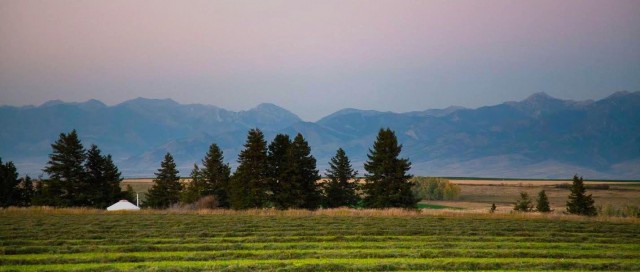
In 2009, Molly Caro May moved to Montana with her husband and built the first home she would ever stay in for more than a couple of years — a yurt. She wrote about the experience in her memoir The Map of Enough: One Woman’s Search for Place.
What have people’s reactions been to your move, generally? More like “I wish I could live your life” or more like “How the hell are you doing this”?
I hear a lot from people that they wish they’d done something, if not necessarily this particular thing. Lots of people tell me, “I had an opportunity when I was 25 to choose this wild adventure and I didn’t choose it,” or “I’ve been in this dead-end job for years and missed out on all these chances.” Definitely, people who are lifetime city dwellers tend to ask a lot of questions like, “What do you mean, you didn’t have a bathroom?”
I bet those practical aspects — like the lack of a bathroom — weren’t a big deal to you, right? You were raised traveling around so much.
Yes. Until I was about 10 years old, I lived outside of the States, relocating every year or two. Then we moved to America and still moved around constantly. My father and grandfather had grown up that way — I really come from a lineage of people who never settled in one place — and in that way, my brothers and I all have a very flexible core. You could tell me tomorrow that I was moving to Japan and I’d be like, “Sure.”
That said, I’m almost 35 now, and as I get a little bit older, things are a little more of a shock than they used to be. When I moved here I was really convinced I would be eaten by a mountain lion. But peeing outside was never a big thing.
Yeah. I don’t think people understand how easy it is to adjust to that sort of stuff.
Definitely. People are so much more adaptable than they think they are.
So where are the places you’ve lived?
I was born in Australia, then moved to the Dominican Republic, Spain and Mexico. In the States I lived in Texas, Florida, and went to college in Indiana, studied abroad in South Africa for six months, then lived in Vermont, New Mexico, Boston, New Zealand, and New York. Then I moved here to Montana.
In your book you talk about getting antsy at the year and a half mark whenever you lived anywhere. Was that just a place-based desire for newness or did it ever bleed into other personal needs?
It’s mostly place-oriented, but also a bit job-oriented too. I wanted to be stimulated in different ways, and I had this idea that I could remake myself in a new place — like, if I got tired of myself, I could go somewhere new and be better. I had also always been very scared of a life where you go to the same restaurant every Sunday. The idea always felt stifling. And my dad had moved around all his life, so that was my guiding example.
What was your dad’s career like?
He worked for Colgate Palmolive, in the marketing department. And actually, he could have stayed in any of those places if he’d wanted to, but he moved around by choice. But where we’re different is that he was a businessman through and through, and for me, the idea of being bound to one desk for the rest of my life is something I have actively chosen to avoid.
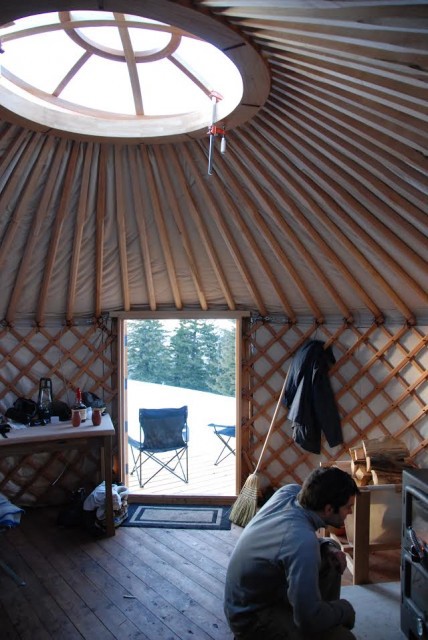
So you were in New York when you got this idea, living with your husband.
Yes. We loved it, but we’d been there for 3 years, and we were both ready to move on. We didn’t have much money at all, and we needed a place to go where we could take some risks in terms of career, sort of —
Without hemorrhaging money.
Exactly. And my family had bought this land in Montana and so the most obvious possibility was for us to caretake in exchange for rent. We didn’t really have the intention of staying, but we’d always wanted to build a yurt, and this was a place we could do it. We didn’t hatch the idea of staying there permanently at all — we had to ask their permission, we were sort of feeling the idea out.
Why Montana in particular?
We have close family friends who live here, so we’d come here a few times as a family, and my parents were looking for a place to sort of offer us a home base. We’d never had a home base as a family, and Montana is central in the States and also so beautiful. They described it as their gift to us. Instead of one day gifting us money, they would gift us this place to gather as family.
Did you feel the absence of a home base when you were a kid? Or did you like not having one?
I always went to international schools, so it felt normal to me. We did come back to the States every summer for a couple of weeks, and my cousins in Illinois had a rooted lifestyle that felt very American to me, and I did have a part of me that wanted to ride my bike to school or whatever I imagined a more traditional childhood to be. But I was never sad when we moved around. It wasn’t till Montana till I discovered that there was a core part of me that really wanted to feel like I belonged somewhere.
Yeah. I wonder that about me and my friends — when we’ll be able to really feel and internalize that desire, even in a generalized sense.
Choosing one thing is terrifying. It wasn’t terrifying to our parents’ generation, but it is for us. And I don’t know if that’s snowballing even more for younger people, I wonder a lot about that.
But we planned on going to Montana just as a retreat at first, a place where we wouldn’t need much money.
I’m assuming you were good at camping and stuff already?
Yes, that’s an important piece of the picture. I’d never been to a place with huge predators or lived in a mountain town, but I’d done a lot of camping as an adult, I was comfortable backpacking.
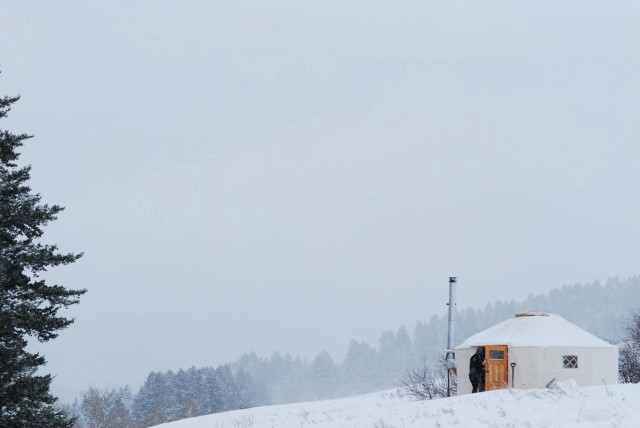
The yurt is such an interesting part of this — a yurt is the single constant of a nomadic culture, its only physical root. In wanting to build it, were you working against your own conception of yourself as a wanderer or were you embracing it?
That’s a good question. My husband loves the yurt purely for its architectural structure; for me, it was — well, romantic is the wrong word, but I was attracted to the idea that I could build a house, that I could live in something that has no membrane, that’s circular, where you can hear all the sound around you.
And we truly had the vision of building it, spending money to build it, and then having this structure that we could move anywhere around the world as long as we could drive it there.
So, both at once.
Yes, absolutely.
What does your husband do?
He’s a furniture designer.
A very good person to do this with!
Definitely.
Talk to me about actually building it.
We bought a couple of books about building yurts — we wanted to build it off a traditional Mongolian ger style, not the Seattle Pacific yurt that comes in a kit. My husband actually designed it and sketched it out, and he set up a shop in Montana, and we built it there. The whole time, I had no idea how to do anything — I learned along the way, just doing what he told me to. But we were really getting in there. We soaked the planks in the pond to steam bend them.
It’s a beautiful structure, so simple. It’s got those latticed walls, the roof, which connects to the skylight, the door, and that’s it. And, you know, we did have the benefit of using power tools; we weren’t whittling our wood or anything.
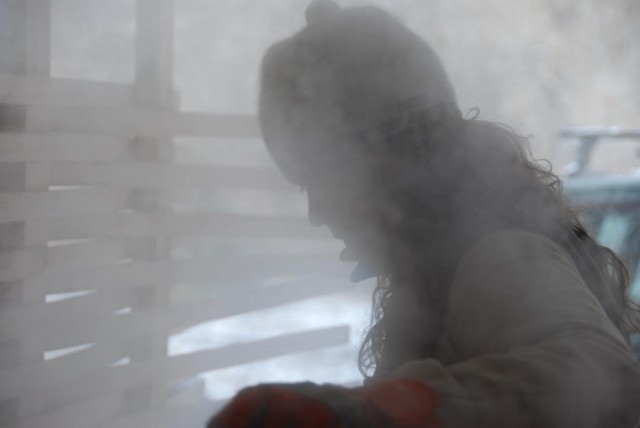
How long did it take, start to finish?
Three or four months of working pretty much full time on it.
I was around yurts a lot in Peace Corps and I was so interested in all the old rules — the women on the left and the men on the right, etc. How much did you think about the traditions attached to the structure?
Oh, totally. You never sit with your feet pointed towards another person, you can’t step into the door unless you’re invited, and there’s that gender divide. We obviously didn’t sleep on different sides or anything! But, I did think about that stuff. There was one moment when I was tying all the khana together and I did it wrong — right to left, instead of left to right, which is traditional. So I undid everything and started over, superstitiously.
How many square feet inside your yurt?
200.
Oh my god. How do you deal with that if you’re in a fight?
Well, we had a log cabin down the way to keep groceries in and shower in, and we’d totally use it — we weren’t trying to prove anything about our ability to rough it. There definitely were moments where we would get in an argument and it was like, where do you go? It’s negative 20 out. We had a few times where one of us would just stomp into the white wilderness. But I wasn’t scared of that; I knew it would happen from time to time.
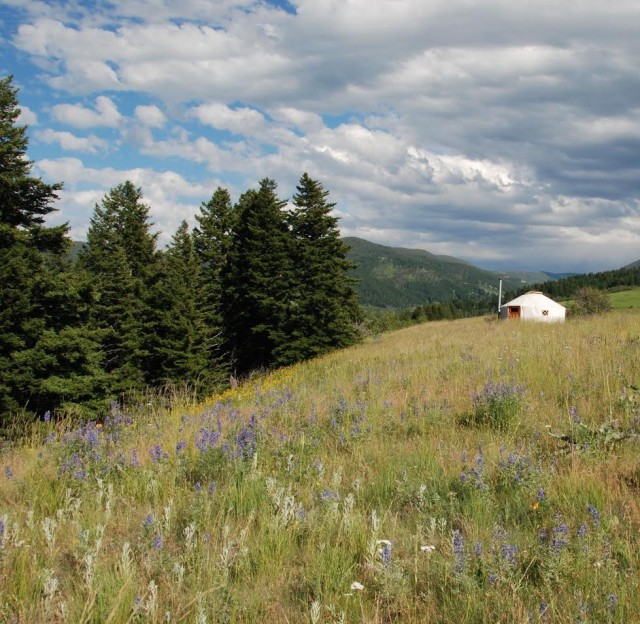
Having a cabin makes this sound a lot more feasible — I was going to ask you about that practical stuff: electricity, food, water, phone, internet.
The cabin has electricity and a touch-and-go internet connection, and the yurt was on a hill high above it. But halfway through our time here we got a solar panel at the yurt, which let us have lights and play music, and we always cooked on a Coleman stove up there, and slept there.
I bet sleeping there was amazing.
It was. It was really sensory — the wind would blow right through.
What was the scariest moment of living there?
Once, in the middle of winter, I’d been in the yurt for two or three weeks by myself — or, alone with my big dog — and he was growling at the door, as if there were an animal out there. And I had that feeling of like, “Okay, here I am, I can’t call anyone,” and it was terrifying.
Now, of course, I realize that even if there was a wolf or a mountain lion out there it couldn’t have broken through the yurt.
Did your brain change in any way while you were out there?
I didn’t know it at the time, but this really systemic change happened for me. It sounds cliché but is very true: everything slowed down. There was a deeper calm there, nothing was as high-pitched as before.
It was important for me as a writer to have that chance to be away. Some people thrive in the center of everything, but I get overwhelmed by everyone doing amazing things — I start thinking that whatever I’m doing is not amazing enough. It was helpful to be away and not give a fuck about what everyone was doing, and spend a day just watching deer.
When did you decide to write your book?
I didn’t start writing about Montana until we’d been living in the yurt for a couple of months. At the time I was shopping around a separate book idea, and one agent said, “Well, what you’re doing right now, that’s a better proposal.”
At the time I said no — I thought it was just the cheesiest concept for a book. But I kept a Word document for myself, and a few months later I started to see the book. It took me probably two years to write.
What did you miss about your old life?
In some moments I started to feel like I was trapped — the yurt was a tent, nomadic, but still stationary. And I missed community. Seeing friends, girlfriends in particular. So I did miss getting out, wandering.
You’ve been there for five years — is that the longest you’ve ever been anywhere?
Yes.
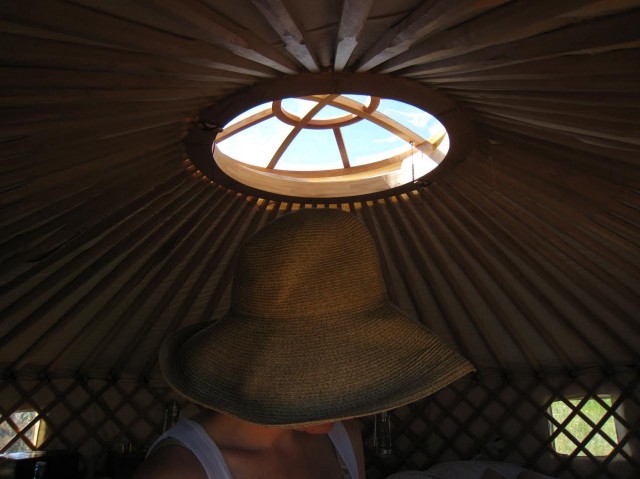
Have you gotten rid of that itch to keep moving?
You know, a few years ago I met a nature writer at a conference and I was talking to him about how I thought my generation feels a real responsibility to move places and connect across difference — which is good, but results in no one being rooted.
His response was so simple and so obvious, but it’s really stayed with me. He just said, “Do both.” He said that people need to have a place to speak from, but then they can also leave, and that’s it.
So that’s what it’s come to. The deal I’ve made with my husband is that this is our home base, but every five or six years we leave. I don’t care where it is, but I hope one of us will go after a really amazing opportunity and we’ll just go. It would be hard for me to think I’d live in Montana for the rest of my life and never live anywhere else again.
Did having your baby influence this in any way?
Because I was raised the way I was raised, I have this understanding that my daughter can come anywhere with me. She’s one year old now; we just did this book tour together.
Does your husband have the same innate desire to travel as you do?
We’ve been together since we were 19, so there’s been lots of evolution in both of our stances on things. But he’s far more rooted than I am — he grew up in one place, in one house.
At the same time, this wasn’t something I had to fight for; I didn’t have to say, “I’ll only marry you if we can do this.” What’s really lucky is that we can do this because we’re both self-employed. There are five million downsides to being self-employed, of course, but you have incredible freedom.
Did you ever wish you had more of a desire to stay in one place? I’ve wished that a lot for myself.
No, I really identified with being a wanderer. I hid behind it for a long time, like, “I’m awesome, look: I’ve lived in all these places.” Whenever I felt insecure, that’s the card I played.
What’s your next move going to be?
My grandparents grew up in Chile, so I have a fantasy of going back there and exploring some family roots. And both sets of my grandparents lived in Japan after World War II, and my husband’s aesthetic is really in line with Japanese woodwork, he does that traditional joinery. But ultimately, it really comes down to finding a kickass opportunity — I’d go anywhere, even if I didn’t know anything about it.
Molly Caro May is a graduate of Middlebury College, and has worked as a teacher, artist’s model, apple and cherry picker, lab assistant to a clinical herbalist, barista in a seaside town, opera caterer, field assistant to a frog biologist, conservation program developer, mentor to at-risk teenagers, vegetable farmer, and in the editorial department of a New York based publisher. She now lives with her husband, daughter, and hound in the Gallatin Valley of Montana. The Map of Enough is her first book.